Apparently the best thing about today is the 5-1 score (Liverpool beat Arsenal) but I'm sure there will be other treats in store! We were heading to Valladolid, also known as the Sultaness of the East for her importance in trade in the peninsular, via the toll road, some 140km of almost straight Romanesque road with only a handful of other vehicles, and a great coffee stop halfway. It is also famed for an anti-hacendado statement from Mayan rebels which was the chispa or spark which ignited the 1910 revolution. We had lunch in Las Campanas, named for the bells from an old temple that still hang from the ceiling. Never one to shy from a challenge, in true Popeye style, Chris opted for the Agua de Chaya (spinach water) which fortunately came out more like a sweetened spinach smoothie rather than the cooking water from yesterday's veg, while I ducked the challenge and had iced tea. Chris followed on with a chip butty Mexican style ... garlic and cheese potatoes in tortillas!
Fortified, we explored the town. Valladolid centres on the Catedral de San Gervasio and the Parque Principal with its pretty white loveseats and fountain around a statue of a woman in traditional Yucatan huipil.
The traditional Mayan dress or huipil, is a white cotton dress adorned with bright, flowered embroidery, still worn by many women and are for sale everywhere.
We wandered into a couple of the old colonial buildings which now house museums and restaurants, including La Casona which has a contemporary fountain erected in the honor of Our Lady of Candelaria, patron saint of Valladolid made by the artists from the Xcaret theme park.
Seemingly not your typical souvenir ... but skulls and skeletons are everywhere!
They commemorate The Day of the Dead, held on 31 October and a public holiday, when Mexicans visit graves with gifts for the dead, like sugared skulls. While a catholic festival, there was already a Mayan tradition of believing your dead relatives were with you all the time, and also the Aztec festival to the goddess Mictecacihuatl. In more modern times, Posada made an etching called La Calavera Catrina of a female skull dressed in very smart European style hat, as a satirical portrait of Mexican natives who, Posada felt, were aspiring to adopt European aristocratic traditions. The image was taken up by Diego Rivera in his mural Dream of a Sunday Afternoon in the Alameda Central showing Catrina together with famous people from Mexican history, and she has become a popular modern icon of the Day of the Dead.
We ended with a visit to Cenote Zaci which is close to the centre of town, and was the water source for a former Mayan stronghold called Zaci. Cenotes are freshwater sinkholes and pronounced say-notay, but we just admired from the edge and didn't go for a dip.
We were braver the next day, visiting a pair of Cenotes just outside town. X'keken, which means pork in Maya, was named for the pig that came back covered in mud even in a drought as he had found the cenote. It was a huge cave with stalactites hanging down, catfish swimming in the water and a shaft of light from a hole in the roof making the water glow turquoise. A few locals were taking a dip, often with life jackets so they can just relax in the water. Samula had tree roots hanging down from the hole in the roof, and a very bright shaft of light.
Later we went to 'Momentos Sagrados Mayas', a play portraying a Mayan festival from the eastern Yucatán Peninsula acted by community groups who want to keep their traditions, customs, language, dance, music, and ancestral ceremonies alive. Even in the the context of a village celebration, death appears firstly with a funeral procession and later with the ritual killing of the bull, showing the open acceptance in Mexico that death is always with us.
Thanks to the wonders of science, this evening we were able to buy some cricket World Cup tickets online for England v Sri Lanka in Wellington 1.3.15 ... I think another trip is coming on ... watch this space!
We are staying at Tunich Beh, a small central hotel, with a lovely room open breakfast area and pool ... and some great towel art. A couple of small hitches - the grid of one way streets makes getting to the hotel a slight challenge, but we made it, and if you want a hot shower, it helps if you know C means caliente not cold on the taps!
Our last day in Vallendolid and we spent the morning touring Casa de los Venados - House of the Deer, private home of fanatic Mexican folk art collectors John and Doriane Venator, which we had been told about by Connie and Ed who we met in Puerto Morelos. Not only have the made an amazing job of the house renovation, but it is a treasure trove, including works in every medium. The entrance hall contains a huge mural made up of some 150 sculpted panels showing everyday Mexican life.
Interesting furniture includes Frida Kahlo and Diego Rivera who appear to be visiting ... and also the dining room chairs painted with famous Mexican people.
The Tree of Life is a Mayan concept, which was used in the first sculptures by the Spanish to teach bible stories, but these are contemporary and are another example of the Mexican way of accepting that death is part of the circle of life and can be depicted quite freely in art with living and dead orchestras.
Catrinas, metalwork, wood and the Los Venados emblem ...
That afternoon, we drove to Ek Balam, a Mayan site where only the ceremonial centre has been excavated. We saw the Oval Palace, two temples side by side called The Twins, The Ball Court and the Acropolis which is some 500ft wide and 100ft tall. Halfway up, there is a stucco area with the entrance to a tomb, decorated with lower jaw and skull and believed to contain the tomb of Ukit Kan Le'k Tok', an important ruler in Ek Balam. The view from the top shows just how flat and densely jungled this part of the Yucatan is. More about Mayan ruins later.
We had another great meal at Conato 1910, once the meeting place for revolutionaries, with the surrealist image of Frida Kahlo flying El Quetzal, a Mayan divine bird.
We have really enjoyed our stay in Valledollid which has the feel of a provincial town rather than a tourist attraction, and although the town was built by the Spanish, it definitely feels Mayan with examples of their culture at every turn, including the skulls!
Next stop ... Chichen Itza.
Valladolid ... The Place to Get a Head!
Saturday, February 08, 2014
 Valladolid, Yucatan Peninsula, Mexico
Valladolid, Yucatan Peninsula, Mexico
Other Entries
Comments
2025-05-23
Comment code: Ask author if the code is blank

 Valladolid, Yucatan Peninsula, Mexico
Valladolid, Yucatan Peninsula, Mexico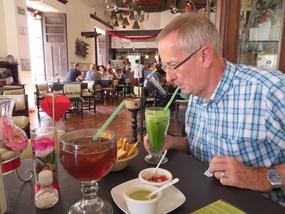
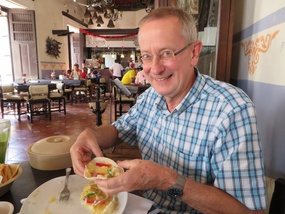
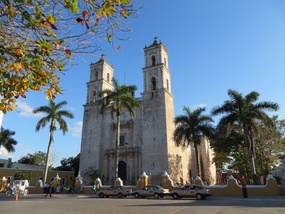
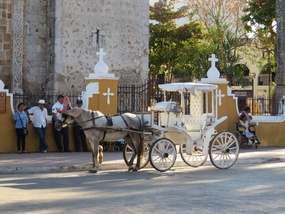
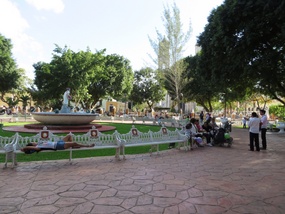
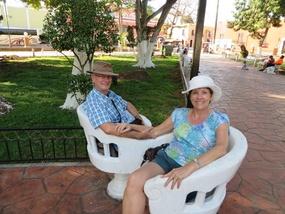
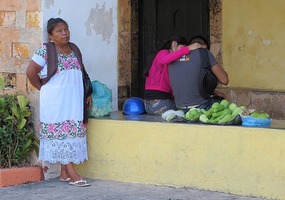
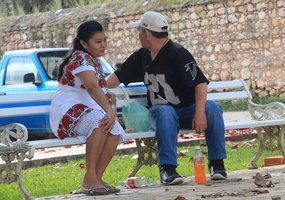
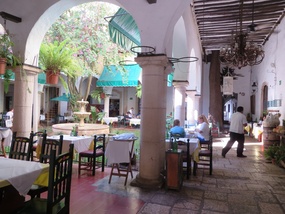
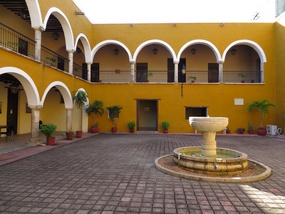
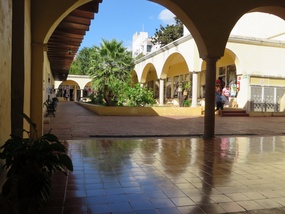
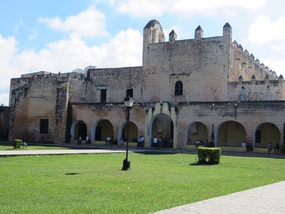
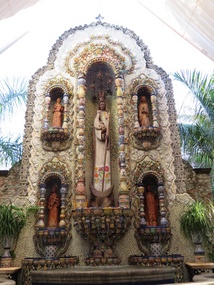
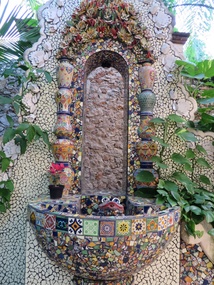
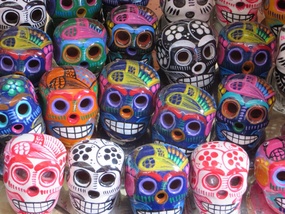
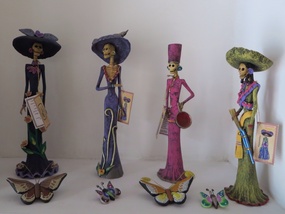
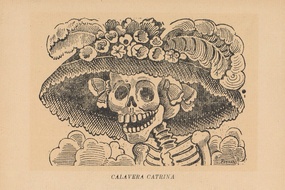
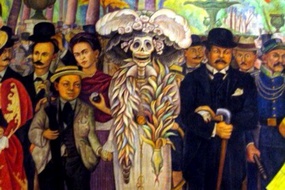
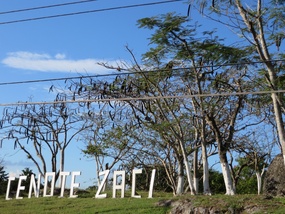
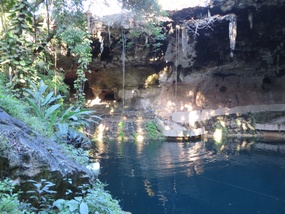
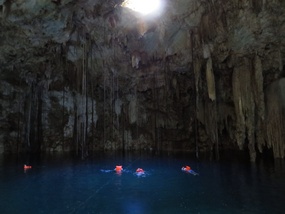

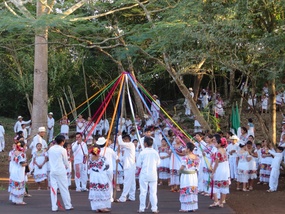

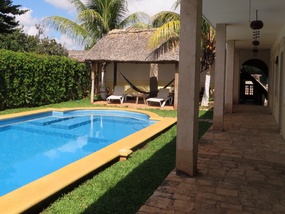


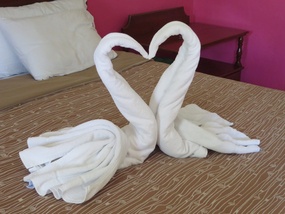
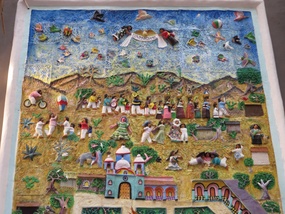
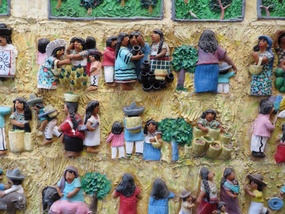
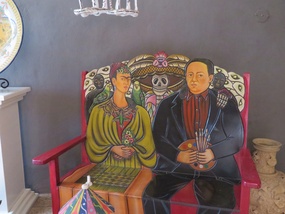
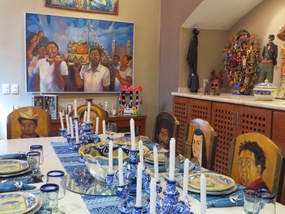
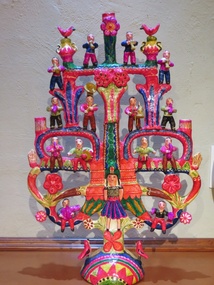
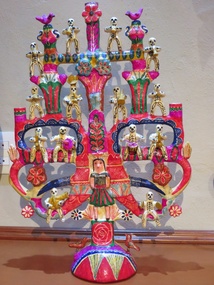
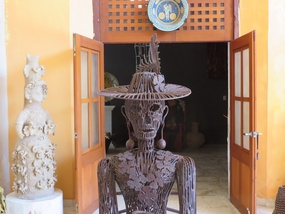
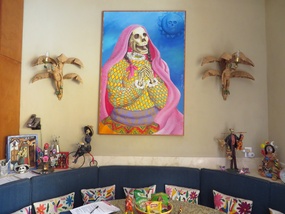
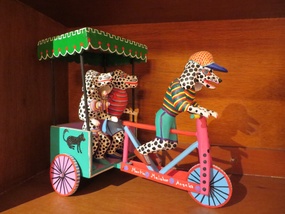
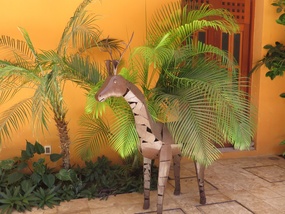
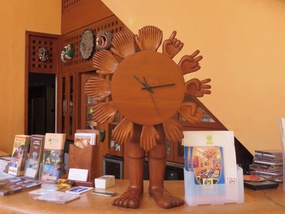
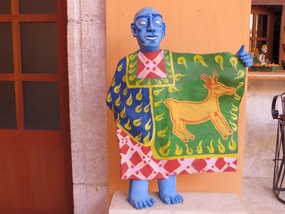

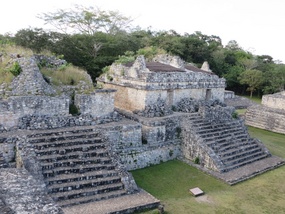
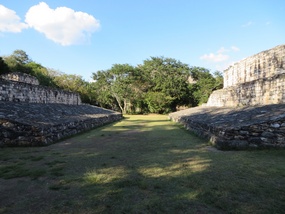
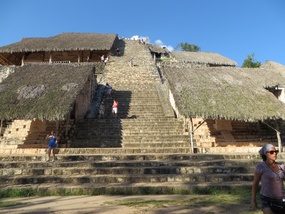
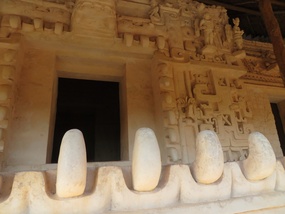
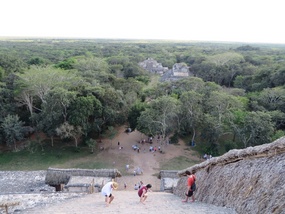



Yoka
2014-02-11
Hi Chris and Elaine,
Looks like you two are having a marvellous time. Beautiful, interesting and colourful country. With your detailed description It almost feels that I am there with you. Keep up the good work and above all have fun. It is nice to see you two in shorts, almost hard to believe it is warm there. We are still having rain! Your house is fine - no floods here! x